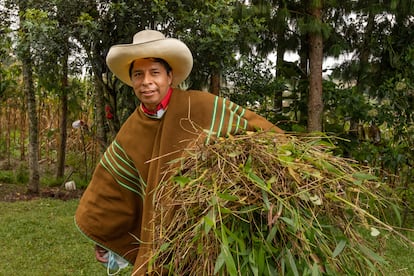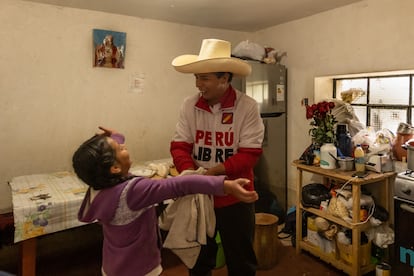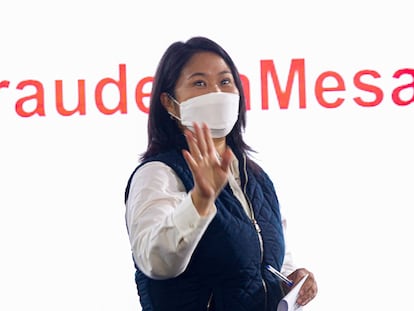Pedro Castillo, the barefoot candidate poised to become the next president of Peru
EL PAÍS traveled to the remote mountain region where the man who currently holds a narrow lead in the vote count grew up, a land that has shaped his political ideas and personal beliefs


The little boy would get up every day at 5am, when it was still dark out. After preparing a lunch by candlelight in the kitchen, he would put on a poncho to ward off the cold, slip a piece of plastic in his pocket in case of rain, and set out on a two-hour walk to school that took him over mountains and up steep paths. The route bordered cliffs at altitudes of 3,000 meters – it felt as though he were in the ceiling of the world. The clouds blocked the view of the abyss opening up at his feet. Slim and short for his age, he would gesture vehemently with his hands the entire way, as though he were an orchestra conductor. The neighbors who watched him go by as they tended to their corn and potato crops were puzzled. One of them finally went to see his mother.
“You should get Pedrito cured,” he told her. “He is unbalanced.”
That day, she waited anxiously for her son to come home from school and asked for explanations. The people of the village thought he was losing his head, she told him. “Pay no attention to them, I am not ill. I am writing out my schoolwork in the air. That way, when I get there, I already know it,” he replied. Then he kissed his mother and went to sleep.
Doña Mavila Terrones recalls that day, saying it was the moment she realized that her son was special, that he would go far in life despite having been born in San Luis de Puña, a poor, remote area of Peru. “But I didn’t think he would rise so high! We are just peasants,” adds Ireño Castillo, an elderly man wearing a palm leaf hat. These are the parents of Pedro Castillo, the leftist schoolteacher who has a short lead in the race to become the next president of Peru following a run-off vote on Sunday. Over 99% of the ballots have been counted, although his rival is claiming fraud and asking for a review of 300,000 votes. Castillo declared himself the winner late on Tuesday.
On the Wednesday before the run-off, shortly after receiving their first dose of a Covid-19 vaccine, Castillo’s parents went to pray inside a dark, damp church. They placed three white candles near the shrine to Our Lord of Mercy, to help their son Pedro defeat his conservative rival Keiko Fujimori, daughter of former president and autocrat Alberto Fujimori and a woman who grew up in the capital, Lima, a city of skyscrapers facing the sea. The backgrounds of both candidates could not be any more different.

“Lord, listen to us,” whispered Doña Mavila, kneeling in church as her husband sat on a pew. Ireño Castillo was born 85 years ago on a hacienda owned by the Herreras, a family of landowners from the mountains of Cajamarca, in the Andes. Neither he nor his wife ever went to school, and they don’t know how to read or write. Ireño worked some land, for which he paid rent to their owners until June 1969, when General Juan Velasco Alvarado introduced agrarian reform after staging a coup that took him to power a year earlier. He shared out the land, which had been in just a few hands, among the peasants. “We stopped being slaves,” recalls Ireño. At his son’s rallies, there are often black-and-white portraits of the general, who was overthrown in 1975.
During the first weeks of campaigning, Castillo, 51, was leading in the polls by as much as 20 points, although this distance was reduced to a technical tie toward the end. At the first round of voting, he secured 19.09% of the vote while Keiko Fujimori attracted 13.36%. Both candidates are socially conservative, but the differences lie in their economic ideas for the country. Fujimori’s Fuerza Popular party and the Peruvian establishment have conducted a very aggressive campaign against the unionist Castillo, whom they accuse of wanting to destroy democracy and replace it with a communist system.
Castillo has signed two democratic pledges in which he promised to protect the nation’s institutions. At the debate last Sunday, he said over and over again that he would respect private property, the pensions system and businesses. He reached out to urban left-wing voters, who might be tempted to view Fujimori as a less risky option.
Castillo has focused his campaign on the need to recognize healthcare and education as fundamental rights, as well as on battling corruption, which is the weakest point for his rival – Fujimori is dealing with several open cases against her. But Castillo represents a Marxist-Leninist party named Perú Libre, whose leader Vladimir Cerrón was removed from his position as governor due to a corruption case. Cerrón also espouses dogmatic leftist views and feels sympathies for Latin America’s populist, authoritarian governments. Castillo has gone to lengths to distance himself from him.
But some if his statements have created controversy. One time he said that Venezuela is a democracy; another, that once in power he would hold a referendum about approving a constituent assembly to draft a new constitution. Sometimes he has had to rephrase his own remarks. First he said he would end the pension system, then that he would only reform it. At rallies he has railed against extraction companies, leading Fujimori to assert that he meant to nationalize them. Castillo says he wants to negotiate with the mining and gas companies so they will reinvest a percentage of their profits in the country.

Castillo’s path from a remote mountain location to the doors of power has been a long one. As a child he juggled school with farm work. He carried water, cooked and collected firewood. “And he soon showed a lot of good sense. He would show us how to do things better,” says his older sister, Mercedes Castillo, as she sows cassava seeds. As teenagers, both of them went to work in the Peruvian Amazon region, where they tended to rice crops. They also sold ice cream in the cities. Castillo was saving to pay for school, and that explains why he was two years behind in his secondary studies. It was in class that he met Lilia Paredes, a devout and temperamental woman who would become the mother of their three children.
He studied to be a teacher, then started working in Puña, his home town. Most of the students were related to him in some way. Even now, 25 years later, the school teacher is Castillo’s own niece, and her six students have some kinship with the candidate. Time seems to have stood still here, where Castillo is viewed as a minor deity. It is difficult to find anyone in the village who does not have a personal story to share about his kindness, his talent or his leadership skills. Some even say that they cry when they hear him talk. Castillo has become something of a legend in these parts.
He first entered politics in 2002, when he ran for mayor of Anguía with Perú Posible, the party of Alejandro Toledo, who served as the first president after a decade-long period of authoritarian rule by Alberto Fujimori. Castillo was defeated, but he remained with the party until 2017. Castillo and Toledo both share humble origins. Toledo’s father was a boot polisher. But Toledo studied in the United States on a scholarship, and before running for president he had worked as an economic analyst in Lima. He was a city man. Castillo, on the other hand, remains a country man. The day after he won enough votes to go to the run-off, reporters who went to interview him found him walking barefoot in the grass, carrying a pail. He had just milked a cow.
In 2017 Castillo became a unionist leader during an education strike. His demands for better pay for teachers, among other things, made him the visible face of the education community as it negotiated improvements with members of Congress. He rode a wave of popularity, but when the strike was over people forgot about him. And when he became a presidential candidate, not everyone remembered him. But the teachers’ union backed him. At his rallies, Castillo likes to wave a giant pencil, and his campaign slogan is “no more poor people in a rich country.” He has traveled extensively throughout the country, and in the space of one month there have been 32 songs written about him, in styles ranging from cumbia to modern music. His popular dimension is unquestionable.
Castillo now lives in a nine-room house on a hilltop in Chugur, the village where he walked to as a child to go to school. His oldest daughter, Jenifer, recalls that in January his father told him to ask the reverend to come for lunch. He also asked his wife to prepare a chicken soup. After the meal had concluded, everyone shook hands and Castillo announced that he wanted to be the next president of Peru.
“Amen,” was the reply.
English version by Susana Urra.
Tu suscripción se está usando en otro dispositivo
¿Quieres añadir otro usuario a tu suscripción?
Si continúas leyendo en este dispositivo, no se podrá leer en el otro.
FlechaTu suscripción se está usando en otro dispositivo y solo puedes acceder a EL PAÍS desde un dispositivo a la vez.
Si quieres compartir tu cuenta, cambia tu suscripción a la modalidad Premium, así podrás añadir otro usuario. Cada uno accederá con su propia cuenta de email, lo que os permitirá personalizar vuestra experiencia en EL PAÍS.
¿Tienes una suscripción de empresa? Accede aquí para contratar más cuentas.
En el caso de no saber quién está usando tu cuenta, te recomendamos cambiar tu contraseña aquí.
Si decides continuar compartiendo tu cuenta, este mensaje se mostrará en tu dispositivo y en el de la otra persona que está usando tu cuenta de forma indefinida, afectando a tu experiencia de lectura. Puedes consultar aquí los términos y condiciones de la suscripción digital.
More information
Archived In
Últimas noticias
Most viewed
- David King, chemist: ‘There are scientists studying how to cool the planet; nobody should stop these experiments from happening’
- Reinhard Genzel, Nobel laureate in physics: ‘One-minute videos will never give you the truth’
- Mexico completes its trade shift with the entry into force of tariffs on China and countries without trade agreements
- Oona Chaplin: ‘I told James Cameron that I was living in a treehouse and starting a permaculture project with a friend’
- Sinaloa Cartel war is taking its toll on Los Chapitos










































